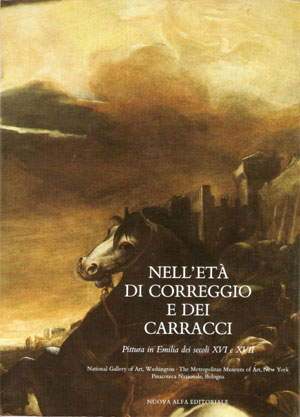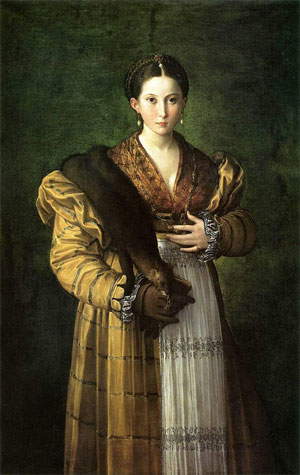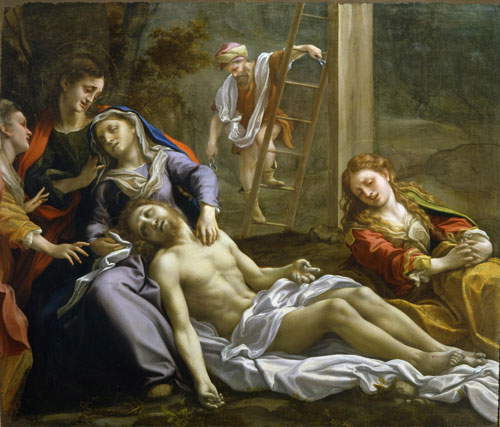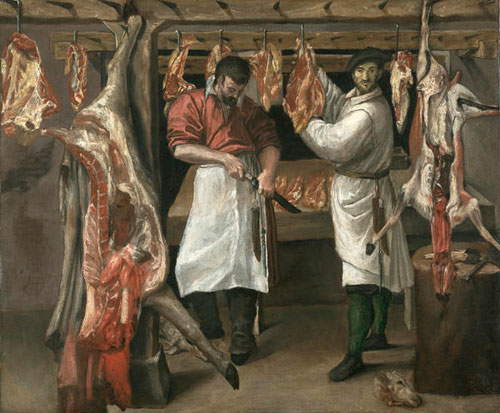Exhibitions in Bologna: In the Age of Correggio and Carracci by Andrea Emiliani (1986)
Andrea Emiliani is one of the most eminent figures in the history of Italian art: a great scholar, a pupil of Roberto Longhi and Francesco Arcangeli, he is also known for having been an excellent superintendent for the cultural heritage of Bologna, Ferrara, Forlì and Ravenna, as well as director of the Pinacoteca Nazionale in Bologna. In April 2011, on the occasion of his 80th birthday, the Giornale dell’Arte obtained an interview from him chronicling his entire long career. The journalist, Giovanni Pellinghelli del Monticello, rightly recalled how Andrea Emiliani was still remembered as “the protagonist of the season of the great exhibitions dedicated to Bolognese art.” Andrea Emiliani, responding, talked about how one of the best exhibitions held in the past in Bologna had come about, his Nell’età del Correggio e dei Carracci.
 |
| Catalog of the exhibition Nell’età del Correggio e dei Carracci. |
The project was international in scope, and began to take shape in 1983. Emiliani, who was then, as noted above, director of the Pinacoteca Nazionale, was visited by John Pope-Hennessy, an English art historian of international standing who at the time was serving as director of European painting at the Metropolitan in New York, and Sydney Freedberg, an American scholar specializing in the Renaissance who had recently become chief curator of the National Gallery in Washington. In past “installments” of this our small series of posts devoted to the great Bolognese exhibitions of the past, we had mentioned how these exhibitions had created considerable interest in Bolognese art: lo and behold, this interest soon manifested itself on a planetary scale. Pope-Hennessy and Freedberg proposed to Emiliani that they collaborate on an exhibition that would focus precisely on Bolognese art: the idea was to organize an exhibition that would arise from the joint work between the three museums, namely the Pinacoteca Nazionale in Bologna, the Metropolitan in New York and the National Gallery in Washington. It took three years to arrive, in 1986, at the opening of Nell’età di Correggio e dei Carracci, which was curated by Andrea Emiliani and the then director of the National Gallery in Washington, John Carter Brown.
The exhibition opened in Bologna on September 10, and was held at two venues: the Pinacoteca Nazionale and the Museo Civico Archeologico. The exhibition, which lasted exactly two months and ended on November 10, 1986, would then leave the city of Bologna in the following months to go “on tour” to Washington (from December 19, 1986 to February 16, 1987) and New York (from March 26 to May 24, 1987). The Bologna stop was a huge success: in just two months, one hundred thousand people crowded the rooms of the two venues that housed the exhibition. The exhibition’s intent was to retrace the milestones of Emilian painting between the sixteenth and seventeenth centuries, with a focus on what were considered the region’s main hubs: Parma (Correggio, Parmigianino), Ferrara (Dosso Dossi and Bastianino) and Bologna (the Carraccis, Guido Reni, Guercino, Domenichino, Francesco Albani).
 |
| Parmigianino, Antea (c. 1530-1535; Naples, Museo Nazionale di Capodimonte) |
Two hundred and two masterpieces of Emilian painting, from the sixteenth to the late seventeenth century, were exhibited: they ranged, as the title suggests, from the refined painting of Correggio, to the achievements of the Carraccis, and their influence on Emilian art in later years. Essentially, the exhibition echoed the ideals of Cesare Gnudi, who had passed away in 1981, and the exhibition therefore took the form of a bit of a tribute to his memory: In the Age of Correggio and the Carraccis focused, in fact, mainly on the classicist strand of Emilian art. And, for that matter, starting from the refined and delicate art of Correggio constituted a bit of an explicit statement of intent. The visitor had at his disposal an interesting selection of Correggio’s masterpieces, such as the Lamentation over the Dead Christ in the National Gallery in Parma, in which the oblique cut of the composition makes the viewer more involved in the scene, making the whole thing seem to unfold before his eyes: this modern conception of space was called, by Sydney Freedberg himself, “Correggio’s boldest act of innovation.” Parmigianino’s Mannerist impulses, on the other hand, were represented by masterpieces such as the Conversion of St. Paul at the Kunsthistorisches in Vienna and also by his portraiture, with pieces such as theAntea or the indecipherable and mysterious Portrait of a Man with Book at the City Art Gallery in York.
 |
| Correggio, Lamentation over the Dead Christ (c. 1524; Parma, National Gallery) |
From the Parmesan experiences would unravel the thread that would later lead to the birth of the Carracci school: the exhibition insisted in particular on how Parmigianino’s example had been important for Ludovico Carracci and how, on the other hand, Correggio’s refinement would mark Annibale Carracci’s classicism. Indeed: Correggio was seen as a fundamental starting point for later Emilian experiences. From Carracci’s classicism would later spring the seventeenth-century Bolognese school, with such preeminent figures as Guido Reni (discussed in connection with the 1954 exhibition), Domenichino and Guercino. Although the exhibition focused, as mentioned earlier, mainly on the classicist strand, it would certainly have been incomplete had it not examined the more distinctly naturalist component of the Carracci school, and of Emilian art in general: naturalism was represented by exceptional loans, such as Annibale Carracci’s Butcher’s Shop from the Kimbell Art Museum in Forth Worth, and also some paintings by Caravaggio, whose painting has always been related to that of Annibale Carracci, although the conclusions arrived at over the years have never been unambiguous or certain.
The exhibition succeeded not only in its intent to explode international interest in Emilian painting in its entirety, an interest in any case that had already arisen as a result of the exhibitions of the 1950s, but also in establishing Emilian painting in a broader European context. If in fact there was a tendency to consider Emilian art as an all but Italian phenomenon, the 1986 exhibition contributed to its being considered almost as a moderate Baroque with markedly classical accents. The contribution that Emilian art, in short, had made to art history consisted precisely in its providing an alternative to the more exuberant and dynamic European Baroque. We should also not forget that the 1986 exhibition represented the beginning of a collaboration between the Bolognese institutions and the United States: in 1988, for example, a new exhibition on Guido Reni was organized and held at the Pinacoteca Nazionale in Bologna and then moved to the Los Angeles County Museum of Art and the Kimbell Art Museum in Fort Worth. These were the first traveling exhibitions on a transoceanic scale, and the 1986 exhibition is still an excellent example of international collaboration between major museums, devoted to curating an exhibition with a serious scholarly project, which also succeeds in popularizing, and attracting a large audience.
 |
| Annibale Carracci, Macelleria (c. 1580; Fort Worth, Kimbell Art Museum) |
Warning: the translation into English of the original Italian article was created using automatic tools. We undertake to review all articles, but we do not guarantee the total absence of inaccuracies in the translation due to the program. You can find the original by clicking on the ITA button. If you find any mistake,please contact us.





























